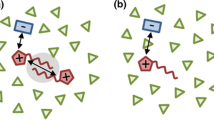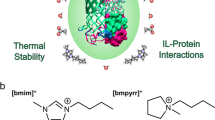Abstract
Ionic liquids have been extensively used as environmentally friendly solvents for enzymatic reactions and other biological systems. Understanding the mechanism of how ionic liquids affect protein stability is crucial for the biological reaction processes and protein storage using ionic liquids as solvents. Although effects of ionic liquids on protein stability have been studied, equilibrium thermodynamics of protein stability in ionic liquids has not been quantitatively measured. Herein, we utilized 19F NMR to measure the equilibrium thermodynamics of protein stability in ionic liquid [C4-mim]Br. Our results show that proteins are significantly destabilized in [C4-mim]Br ionic liquids. Our results suggest that 19F NMR provides a simple and effective way to study the thermodynamics of protein stability in ionic liquids. 19F NMR will be applicable to facilitate the protein–protein interaction study in ionic liquids.

Graphical abstract



Similar content being viewed by others
References
Welton T. Room-temperature ionic liquids. Solvents for synthesis and catalysis. Chem Rev. 1999;99(8):2071–84.
Lozano P, De Diego T, Carrie D, Vaultier M, Iborra JL. Over-stabilization of Candida antarctica lipase B by ionic liquids in ester synthesis. Biotechnol Lett. 2001;23(18):1529–33.
van Rantwijk F, Sheldon RA. Biocatalysis in ionic liquids. Chem Rev. 2007;107(6):2757–85.
Dominguez de Maria P. “Nonsolvent” applications of ionic liquids in biotransformations and organocatalysis. Angew Chem Int Ed Engl. 2008;47(37):6960–8.
Tseng MC, Tseng MJ, Chu YH. Affinity ionic liquid. Chem Commun. 2009;48(48):7503–5.
Hallett JP, Welton T. Room-temperature ionic liquids: solvents for synthesis and catalysis. 2. Chem Rev. 2011;111(5):3508–76.
Sun L, Tao D, Han B, Ma J, Zhu G, Liang Z, et al. Ionic liquid 1-butyl-3-methyl imidazolium tetrafluoroborate for shotgun membrane proteomics. Anal Bioanal Chem. 2011;399(10):3387–97.
Zhao Q, Fang F, Liang Y, Yuan H, Yang K, Wu Q, et al. 1-Dodecyl-3-methylimidazolium chloride-assisted sample preparation method for efficient integral membrane proteome analysis. Anal Chem. 2014;86(15):7544–50.
Sivapragasam M, Moniruzzaman M, Goto M. Recent advances in exploiting ionic liquids for biomolecules: solubility, stability and applications. Biotechnol J. 2016;11(8):1000–13.
Sui Z, Weng Y, Zhao Q, Deng N, Fang F, Zhu X, et al. Ionic liquid-based method for direct proteome characterization of velvet antler cartilage. Talanta. 2016;161:541–6.
Itoh T. Ionic liquids as tool to improve enzymatic organic synthesis. Chem Rev. 2017;117(15):10567–607.
Jin L, Yu X, Peng C, Guo Y, Zhang L, Xu Q, et al. Fast dissolution pretreatment of the corn stover in gamma-valerolactone promoted by ionic liquids: selective delignification and enhanced enzymatic saccharification. Bioresour Technol. 2018;270:537–44.
Du Z, Yu YL, Wang JH. Extraction of proteins from biological fluids by use of an ionic liquid/aqueous two-phase system. Chemistry. 2007;13(7):2130–7.
Ge LY, Wang XT, Tan SN, Tsai HH, Yong JWH, Hua L. A novel method of protein extraction from yeast using ionic liquid solution. Talanta. 2010;81(4–5):1861–4.
Tao D, Qiao X, Sun L, Hou C, Gao L, Zhang L, et al. Development of a highly efficient 2-D system with a serially coupled long column and its application in identification of rat brain integral membrane proteins with ionic liquids-assisted solubilization and digestion. J Proteome Res. 2011;10(2):732–8.
Lin X, Wang Y, Zeng Q, Ding X, Chen J. Extraction and separation of proteins by ionic liquid aqueous two-phase system. Analyst. 2013;138(21):6445–53.
Zeng Q, Wang Y, Li N, Huang X, Ding X, Lin X, et al. Extraction of proteins with ionic liquid aqueous two-phase system based on guanidine ionic liquid. Talanta. 2013;116:409–16.
Summers CA, Flowers RA 2nd. Protein renaturation by the liquid organic salt ethylammonium nitrate. Protein Sci. 2000;9(10):2001–8.
Lau RM, Sorgedrager MJ, Carrea G, van Rantwijk F, Secundo F, Sheldon RA. Dissolution of Candida antarctica lipase B in ionic liquids: effects on structure and activity. Green Chem. 2004;6(9):483–7.
De Diego T, Lozano P, Gmouh S, Vaultier M, Iborra JL. Understanding structure-stability relationships of Candida antartica lipase B in ionic liquids. Biomacromolecules. 2005;6(3):1457–64.
Constantinescu D, Weingartner H, Herrmann C. Protein denaturation by ionic liquids and the Hofmeister series: a case study of aqueous solutions of ribonuclease A. Angew Chem Int Ed. 2007;46(46):8887–9.
Byrne N, Wang LM, Belieres JP, Angell CA. Reversible folding-unfolding, aggregation protection, and multi-year stabilization, in high concentration protein solutions, using ionic liquids. Chem Commun. 2007;26(26):2714–6.
Fujita K, MacFarlane DR, Forsyth M, Yoshizawa-Fujita M, Murata K, Nakamura N, et al. Solubility and stability of cytochrome c in hydrated ionic liquids: effect of oxo acid residues and kosmotropicity. Biomacromolecules. 2007;8(7):2080–6.
Byrne N, Angell CA. Protein unfolding, and the “tuning in” of reversible intermediate states, in protic ionic liquid media. J Mol Biol. 2008;378(3):707–14.
Fujita K, Ohno H. Enzymatic activity and thermal stability of metallo proteins in hydrated ionic liquids. Biopolymers. 2010;93(12):1093–9.
Constatinescu D, Herrmann C, Weingartner H. Patterns of protein unfolding and protein aggregation in ionic liquids. Phys Chem Chem Phys. 2010;12(8):1756–63.
Moniruzzaman M, Kamiya N, Goto M. Activation and stabilization of enzymes in ionic liquids. Org Biomol Chem. 2010;8(13):2887–99.
Huang JL, Noss ME, Schmidt KM, Murray L, Bunagan MR. The effect of neat ionic liquid on the folding of short peptides. Chem Commun. 2011;47(28):8007–9.
Sankaranarayanan K, Sathyaraj G, Nair BU, Dhathathreyan A. Reversible and irreversible conformational transitions in myoglobin: role of hydrated amino acid ionic liquid. J Phys Chem B. 2012;116(14):4175–80.
Dabirmanesh B, Khajeh K, Ranjbar B, Ghazi F, Heydari A. Inhibition mediated stabilization effect of imidazolium based ionic liquids on alcohol dehydrogenase. J Mol Liq. 2012;170:66–71.
Weaver KD, Vrikkis RM, Van Vorst MP, Trullinger J, Vijayaraghavan R, Foureau DM, et al. Structure and function of proteins in hydrated choline dihydrogen phosphate ionic liquid. Phys Chem Chem Phys. 2012;14(2):790–801.
Goldfeder M, Fishman A. Modulating enzyme activity using ionic liquids or surfactants. Appl Microbiol Biotechnol. 2014;98(2):545–54.
Kaar JL, Jesionowski AM, Berberich JA, Moulton R, Russell AJ. Impact of ionic liquid physical properties on lipase activity and stability. J Am Chem Soc. 2003;125(14):4125–31.
Fujita K, Forsyth M, MacFarlane DR, Reid RW, Elliott GD. Unexpected improvement in stability and utility of cytochrome c by solution in biocompatible ionic liquids. Biotechnol Bioeng. 2006;94(6):1209–13.
Klahn M, Lim GS, Wu P. How ion properties determine the stability of a lipase enzyme in ionic liquids: a molecular dynamics study. Phys Chem Chem Phys. 2011;13(41):18647–60.
Rodrigues JV, Prosinecki V, Marrucho I, Rebelo LPN, Gomes CM. Protein stability in an ionic liquid milieu: on the use of differential scanning fluorimetry. Phys Chem Chem Phys. 2011;13(30):13614–6.
Attri P, Venkatesu P. Influence of protic ionic liquids on the structure and stability of succinylated Con A. Int J Biol Macromol. 2012;51(1–2):119–28.
Attri P, Venkatesu P, Kumar A. Water and a protic ionic liquid acted as refolding additives for chemically denatured enzymes. Org Biomol Chem. 2012;10(37):7475–8.
Figueiredo AM, Sardinha J, Moore GR, Cabrita EJ. Protein destabilisation in ionic liquids: the role of preferential interactions in denaturation. Phys Chem Chem Phys. 2013;15(45):19632–43.
Nordwald EM, Armstrong GS, Kaar JL. NMR-guided rational engineering of an ionic-liquid-tolerant lipase. ACS Catal. 2014;4(11):4057–64.
Jha I, Attri P, Venkatesu P. Unexpected effects of the alteration of structure and stability of myoglobin and hemoglobin in ammonium-based ionic liquids. Phys Chem Chem Phys. 2014;16(12):5514–26.
Kumar A, Rani A, Venkatesu P, Kumar A. Quantitative evaluation of the ability of ionic liquids to offset the cold-induced unfolding of proteins. Phys Chem Chem Phys. 2014;16(30):15806–10.
Bisht M, Kumar A, Venkatesu P. Analysis of the driving force that rule the stability of lysozyme in alkylammonium-based ionic liquids. Int J Biol Macromol. 2015;81:1074–81.
Kumar A, Rani A, Venkatesu P. A comparative study of the effects of the Hofmeister series anions of the ionic salts and ionic liquids on the stability of alpha-chymotrypsin. New J Chem. 2015;39(2):938–52.
Lesch V, Heuer A, Tatsis VA, Holm C, Smiatek J. Peptides in the presence of aqueous ionic liquids: tunable co-solutes as denaturants or protectants? Phys Chem Chem Phys. 2015;17(39):26049–53.
Jha I, Venkatesu P. Unprecedented improvement in the stability of hemoglobin in the presence of promising green solvent 1-allyl-3-methylimidazolium chloride. ACS Sustain Chem Eng. 2016;4(2):413–21.
Bisht M, Venkatesu P. Influence of cholinium-based ionic liquids on the structural stability and activity of alpha-chymotrypsin. New J Chem. 2017;41(22):13902–11.
de Borba TM, Machado TB, Brandelli A, Kalil SJ. Thermal stability and catalytic properties of protease from Bacillus sp P45 active in organic solvents and ionic liquid. Biotechnol Prog. 2018;34(5):1102–8.
Satish L, Millan S, Sasidharan VV, Sahoo H. Molecular level insight into the effect of triethyloctylammonium bromide on the structure, thermal stability, and activity of bovine serum albumin. Int J Biol Macromol. 2018;107:186–93.
Warner L, Gjersing E, Follett SE, Elliott KW, Dzyuba SV, Varga K. The effects of high concentrations of ionic liquid on GB1 protein structure and dynamics probed by high-resolution magic-angle-spinning NMR spectroscopy. Biochem Biophys Rep. 2016;8:75–80.
Danielson MA, Falke JJ. Use of 19F NMR to probe protein structure and conformational changes. Annu Rev Biophys Biomol Struct. 1996;25:163–95.
Ropson IJ, Frieden C. Dynamic NMR spectral-analysis and protein folding: identification of a highly populated folding intermediate of rat intestinal fatty acid-binding protein by 19F NMR. Proc Natl Acad Sci U S A. 1992;89(15):7222–6.
Becktel WJ, Schellman JA. Protein stability curves. Biopolymers. 1987;26(11):1859–77.
Cheng K, Wu Q, Zhang ZT, Pielak GJ, Liu ML, Li CG. Crowding and confinement can oppositely affect protein stability. Chemphyschem. 2018;19(24):3350–5.
Smith AE, Zhou LZ, Gorensek AH, Senske M, Pielak GJ. In-cell thermodynamics and a new role for protein surfaces. Proc Natl Acad Sci U S A. 2016;113(7):1725–30.
Li C, Wang GF, Wang Y, Creager-Allen R, Lutz EA, Scronce H, et al. Protein 19F NMR in Escherichia coli. J Am Chem Soc. 2010;132(1):321–7.
Crowley PB, Kyne C, Monteith WB. Simple and inexpensive incorporation of 19F-tryptophan for protein NMR spectroscopy. Chem Commun. 2012;48(86):10681–3.
Evanics F, Bezsonova I, Marsh J, Kitevski JL, Forman-Kay JD, Prosser RS. Tryptophan solvent exposure in folded and unfolded states of an SH3 domain by 19F and 1H NMR. Biochemistry. 2006;45(47):14120–8.
Arakawa T, Timasheff SN. The stabilization of proteins by osmolytes. Biophys J. 1985;47(3):411–4.
Politi R, Harries D. Enthalpically driven peptide stabilization by protective osmolytes. Chem Commun. 2010;46(35):6449–51.
Gorensek-Benitez AH, Smith AE, Stadmiller SS, Perez Goncalves GM, Pielak GJ. Cosolutes, crowding, and protein folding kinetics. J Phys Chem B. 2017;121(27):6527–37.
Kumar A, Venkatesu P. Does the stability of proteins in ionic liquids obey the Hofmeister series? Int J Biol Macromol. 2014;63:244–53.
Funding
This work is supported by Ministry of Science and Technology of China grant 2017YFA0505400, Innovation team of Hubei Province grant 2016CFA002, National Natural Sciences Foundation of China grant 21575156, and K.C. Wong Education Foundation and Chinese Academy of Sciences (QYZDJ-SSW-SLH027).
Author information
Authors and Affiliations
Corresponding author
Ethics declarations
Conflict of interest
The authors declare that they have no conflict of interest.
Additional information
Published in the topical collection Young Investigators in (Bio-)Analytical Chemistry with guest editors Erin Baker, Kerstin Leopold, Francesco Ricci, and Wei Wang.
Publisher’s note
Springer Nature remains neutral with regard to jurisdictional claims in published maps and institutional affiliations.
Rights and permissions
About this article
Cite this article
Cheng, K., Wu, Q., Jiang, L. et al. Protein stability analysis in ionic liquids by 19F NMR. Anal Bioanal Chem 411, 4929–4935 (2019). https://doi.org/10.1007/s00216-019-01804-3
Received:
Revised:
Accepted:
Published:
Issue Date:
DOI: https://doi.org/10.1007/s00216-019-01804-3




